Recommended
system:
Power
Mac G4, Dual 800 MHz
Mac OS X v10.1.3 or later
QuickTime 5.04 or later
Blackmagic Design SD
(supplied)
512MB
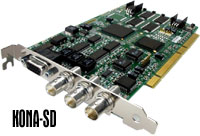 Stealth Serial Port Adapter
Stealth Serial Port Adapter
or Griffen G4Port Adapter
(cable supplied)
40 MB/sec sustained
80 MB/sec sustained for RT
(2/4 Seagate Cheetah 15k
RPM)*
ATTO UL3D Ultra 160
ATTO FC 3300/3305 2Gb
Fibre Ch.
$3,295.00
- AJA Kona SD
Review by Patrick
Inhofer
I've always been an early adopter. Pong,
CD, LaserDisc, DVD, 5 channel surround sound - I'm usually the
first kid on the block to acquire these technologies. As a kid
I taught myself Assembly Language, in the hopes my parents would
purchase a TSR-80 (they didn't). So when it came to deciding
how to power my first wholly-owned editing system, the notion
of running Final Cut Pro under OS 10 using the Kona card seemed
natural.
I did have two major concerns.
I was concerned about working under OS 10 in an uncompressed
environment and concerned about using an unproven capture card
as the centerpiece of my edit room. I will share my experience
using the Kona card in OS 10 with Final Cut Pro. And I'll introduce
you to some of the amazing features found in the newly released
Kona SD 2.0.
Working in OS 10
OS 10.1.x has proven to be amazingly
stable (as I type this, I have After Effects rendering away while
iTunes pulls in a streaming internet radio station playing out
the AES channels of the Kona card). All the things that OS 10
was supposed to deliver (notably pre-emptive
multitasking and protected
memory) work very well. I almost never need to restart my machine
in the middle of an edit session. I haven't yet had a system
freeze. When a program quits it NEVER takes down any other app.
Not to say there haven't been OS
10-induced problems. Most of these problems are minor annoyances.
And detailing each of this issues is a whole other article (and
with 10.2 just around the corner, why bother?).
So, on to the good stuff...
OS 10. The Kona card. Final
Cut Pro. SDI uncompressed.
An unproven OS with an unproven
capture card on a newly ported app pushing massive data rates.
What early adopter could resist the siren song of that combination?
Not me, certainly. And unlike my experience with LaserDiscs,
the Kona experience has been terrific.
Background: The Kona card is a
joint development between Aja (manufacturers of the physical card) and Black Magic Design (developer
of the software codec that supports the card and founded by Grant
Petty, one of the founders of Digital Voodoo). Kona is currently
the only shipping capture card built entirely on and for OS 10.
After some initial bumps (more on that
in a moment) the Kona card has been remarkably stable. I seem
to get upgrades from Black Magic about every three weeks - a
remarkably robust development pace. And these updates usually
introduce new, often powerful, features. And as of yet there
hasn't been a single upgrade fee. Talk about supporting your
early adopters - Kona has it right.
In the three short months I have owned
this card, Kona went from merely supporting a real-time dissolve,
to eleven Real Time effects (five types of dissolves and six
of the Image Control filters). But the first real hint of what
Black Magic had up its sleeves was in the form of a new codec
they had introduced in June, Kona OfflineRT. This codec allows
you to directly capture to the OfflineRT codec - live from the
SDI input. When introduced, this feature didn't make headlines...
but it definitely presaged their intent.
But, like OS 10 itself, Kona does have
some bugs. One of the more serious bugs afflicts a small percentage
of Kona users. If you're one of these users (I am) Final Cut
becomes extremely unstable. Unexpected quits, audio sync
problems and slow screen updates are all problems I experienced.
And while I initially had these problems intermittently, it was
with 1.4 of the Kona codec that they blossomed. I finally sent
an email to Black Magic support and the problem was immediately
identified and a work-around relayed (I had to uncheck a preference).
Since then my system has become a model of stability. The latest
word is Jaguar fixes this problem (although Apple has yet to
specify when Final Cut users can migrate to the recently announced
OS).
A second bug that I've found, is in reality
Operator Error. It involves After Effects; RAM Previews aren't
playing back in real time out of the SDI card (another nifty
feature included when the Kona card initially shipped). As of
this morning it looks like I've got this problem licked. There
are three different preferences to get Real-Time RAM previews
out of the Kona card. If any one of these are wrong, RT is NG.
Hopefully Black Magic will include more precise instructions
in its documentation to keep us old-school linear guys from tripping
over ourselves. But now that I have it working, it's an excellent
feature.
As far as bugs go, that's about it. Not
too shabby.
Kona 2.0
When Black Magic made available to me
a beta version of its 2.0 software, I was very excited. For me,
it was a moment of truth. I would know very quickly if my early
adoption of its hardware was bold, or just plain foolish.
I'm not disappointed.
In fact, I'm ecstatic. Not only are they
moving in the direction hinted at with the development of Kona
OfflineRT, they have done so big time.
Kona SD 2.0 includes two new codecs,
making a total of five codecs supported by the Kona card (ten
if you include the PAL versions). All of these codecs capture
directly to disk in real time. All of them play directly out
of the SDI output in real time. Four of them capture from the
SDI input. The remaining codec actually captures from Firewire!
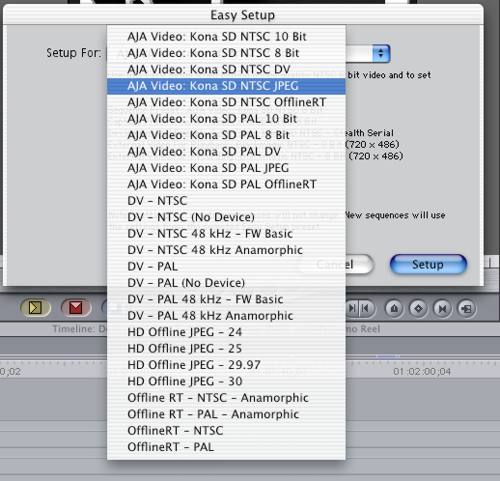
The four codecs that capture live from
the SDI input are:
- Kona 8bit
- Kona 10bit
- Kona OfflineRT
and my favorite new one:
If there was one bit of buyer's remorse
I experienced with the Kona card, it was not having Aurora's
Jpeg codec. That feeling has evaporated with the introduction
of Kona JPEG. It is a 4:2:2 codec, compared to DV's 4:1:1 colorspace,
at a slightly lower data rate. It looks really, really
clean. I'm serious. It's clean.
At around three megs/second, this codec
alone completely changes the way I can approach projects. It
looks good enough to go to air with, although I'll still be uprezzing
my projects to uncompressed. But I'll never have to explain to
my client's client why the video looks so blotchy (a la Avid's
AVR4). And working in 4:2:2 means I can do preliminary color
corrections as I'm editing, saving me some time when I'm in finishing
mode. And now I can take on projects much earlier in the editorial
cycle, since the reduced data rate increases the amount of material
my hard drives store by a factor of eight.
Kona 2.0 doesn't stop there. Remember
I mentioned a codec that can be captured through Firewire? It's
called Kona DV.
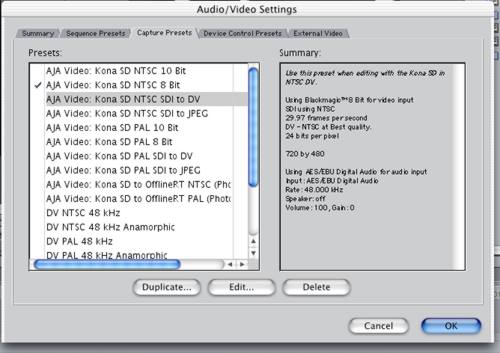
That's right. DV.
You can now capture DV directly through
Firewire (using serial control for accurate timecode, of course)
and output live through the SDI/AES card! While I don't see this
feature impacting my business too much, I'm sure for others it'll
have as much impact on them as Kona JPEG has impacted me.
But wait, there's more!
You can also capture from SDI to the
Kona DV codec. This brings the total number of codecs that can
be captured through SDI to five. This also means you have three
offline codecs to choose from; Kona OfflineRT, Kona DV and Kona
JPEG. Personally, in head-to-head comparisons I find the Kona
JPEG codec more pleasing than DV - mostly because the colors
are much more vibrant and crisp. 4:2:2 really does matter.
H'okay, we're not done yet....
More new features also include:
- YUV render support in Final Cut Pro
- Jaguar-ready Mac OS X Quartz Extreme-ready
- Trillions of Colors, 64bit RGB rendering
in After Effects
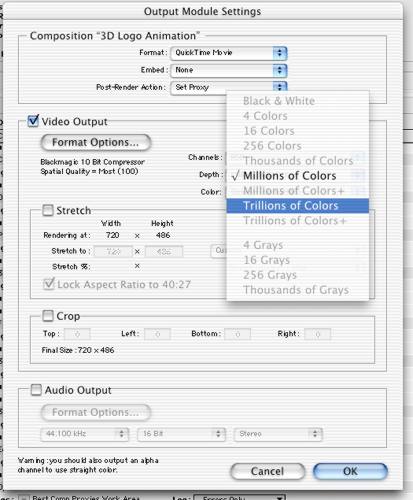
Reality Check
With all this great new stuff, you've
got to be asking, is it all true?
Yes, it is. I've tried them all (well,
except for DV Firewire capture, but I'll be pointing you to another
review in which the author found this feature worked great).
There are some things you need to keep
in mind. When capturing the Kona DV or Kona OfflineRT codecs,
you don't get all those real-time effects that you'd expect -
not if you also want to play out the SDI board. Kona DV forces
you to choose between real-time effects or SDI out. Kona OfflineRT
is more limiting, you have to choose between outputting or editing.
Unlike Kona DV, it's impossible to edit in Kona OfflineRT while
monitoring out the Kona board. With either codec, outputting
via the Kona board requires rendering your effects. According
to Grant Petty these limitations have to do with Final Cut Pro,
not the Kona board.
Also, when capturing to Kona DV via SDI
the documentation states this feature may not work on all computers.
It worked fine for me (Dual 800 with an ATA to SCSI Raid).
Finally, for current users, you will
be pleased to know that we no longer have to do "manual'
installs of the codecs. The new Kona installer puts everything
in the right place (including deleting the necessary preferences)
- except for the Trillions of Colors enabler in After
Effects; for that you'll have to modify AE's preference file
by following the instructions in the Read Me.
Kona 2.1
In the time it has taken me to go from
draft one of this article to draft five (ten days), Black Magic
has let loose Kona 2.1. Didn't I say these guys are a moving
target?
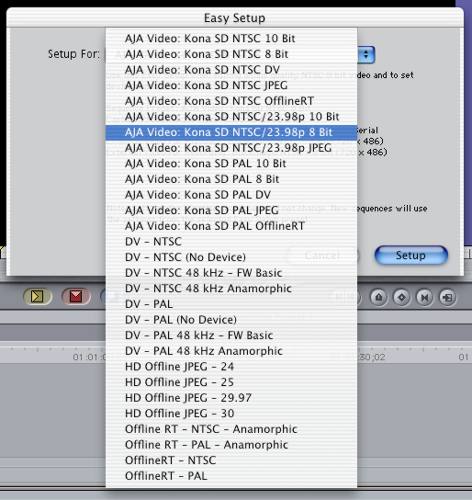
By the time you read this, 2.1 may already
be under a public beta and its main feature is - you guessed
it - a film option! That's right, reverse telecine and, when
playing back from a 24fps timeline out of the NTSC monitor, automatic
3:2 pulldown. No rendering necessary.
Of course, why should they stop there
for just a measly .1 release? How about outputting Kona OfflineRT
at it's native size centered on the screen over black, without
rendering? It's in there.
How much for the 2.1 upgrade to the film
option? For current Kona users, nada. For new Kona purchases,
it's included! I can only imagine the effect Kona 2.0 and Kona
2.1 must be having on their competitors. I'm just glad I'm their
customer. Let them bring it on, it can only be good for the rest
of us.
Looking Forward
In my first draft of this article I wrote
that I wanted to see Kona support a film option. Clearly I haven't
set the bar high enough. There is nothing more I want to see
happen in real time than Synthetic
Aperture's Color Finesse; with all due respect to Apple's
color correcter, Color Finesse is a true professional
color correcter. And having that in real-time on FCP would be
a real boon to my business (but I'll first have to wait for Apple
to fix Final Cut's compatibility with AE plug-ins under OS 10).
There are also some very nice filters in Joe's
Filters I'd like to see supported in real time.
I'd also encourage Aja to solve the BOB
issue that seems to nag at so many editors. If your beef with
Kona is that it doesn't have a BOB and you have the budget for
a beefy Cinewave SDI BOB then you have to check out this
nasty little converter from Leitch to act as your SDI to
analog interface. It's excellent, NTSC/PAL switchable (though
it's not a standards converter) and has so many test signals
even your engineer will be overwhelmed. I highly recommend it.
Conclusion
Options, options, options. The flexibility
of the codecs Kona supports means it's a serious contender for
all but the smallest of budgets. Take into account Apple halting
further development of Final Cut under OS9 and if you're in the
market today for a capture card you can't ignore what Aja and
Black Magic have achieved.
If you're like me, and need to have uncompromised
quality but would like the flexibility of working at several
resolutions without the heavily visible artifacting associated
with OfflineRT or one of Avid's offline codecs, you have to be
very psyched at this unexpected (and totally free) upgrade to
the Kona card.
And if you jump on board now, it's still
soon enough for you to join the ranks of the early adopters.
Unlike mini-Discs, this one is here to stay.
(For more information on Kona 2.0/2.1,
check out Marco
Solorio's in-depth review for even more comments on each
of Kona's features - especially the new film option.)
copyright©2002applePi Editorial, Inc
All screen captures
and textual references are the property and trademark of their
creators/owners/publishers.
Click HERE
for Print Friendly version
Patrick
Inhofer is an
editor, compositor and nice guy. He has 12 years experience in
post-production and broadcast graphics. He is also the guy in
charge of applePi
Editorial, Inc,
a New York City-based editorial design shop. You can praise him
or flame him at articles@applepieditorial.com.